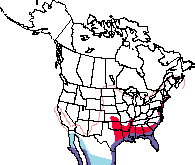Little Blue Heron
Egretta
caerulea
Ciconiiformes
The herons, ibises and allies are large birds, most with long legs and necks. Many live on or near water where they wade in search of prey. Many breed in colonies. This order has five families worldwide, of which two are represented in Washington:
Ardeidae
Herons and egrets are wading birds that generally inhabit wetlands and slow-moving waters. Most are long-legged, and they hunt by waiting motionless, peering into the water, watching for prey. The majority are colony nesters, often raising young in colonies of mixed species. Monogamy is the norm, although pair bonds usually last for a single breeding season. Both parents help build the nest. Typically, the male brings material, and the female constructs the nest, which is usually built of sticks. Both parents incubate, and both feed the young by regurgitation.
General Description
Two records of immatures in Puget lowlands in October; one stayed into January. An adult was seen near Ellensburg (Kittitas County) in June 2002.
Washington Range Map

North American Range Map












